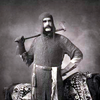Portal:Siberia/Facts
Appearance
Facts 1
- The Azerbaijani geologist Farman Salmanov, who discovered huge oil fields of Western Siberia in 1961, was awarded the title of Hero of Socialist Labor at the unusually young age of 37.
- NASA terraforming expert Christopher McKay has explored the Gobi Desert, Siberia and Antarctica to study extremophilic life forms.
- During the Soviet deportations from Estonia in 1940-1941 and 1944-1951 the Soviet Union forcibly transferred tens of thousands of Estonian citizens to Siberia.
Facts 2

- Jan Czerski (pictured), exiled to Siberia after the January Uprising, became a self-taught scientist and Siberian explorer, thrice decorated with the gold medal by the Russian Geographical Society.
- Orange snow fell in February 2007 in western Siberia.
- Members of Sub-Carpathian Reformed Church were persecuted by communists in the Soviet Union and were sent to Gulag labour camps in Siberia.
Facts 3
- Forest brother Alfred Käärmann hid for 7 years from Soviet officials, spent 15 years in Siberian prison camps, had his passport stamped "annulled" and was banished from Estonia until 1981.
- Eruptions of Anyuyskiy Volcano in Siberia may have inspired legends of places where hunting is banned and smoke and fire rise from the ground.
- In 1866 Polish exilees to Siberia staged an uprising trying to escape to China.
Facts 4
- Henry Lansdell (pictured) distributed multi-lingual religious tracts and Bibles in hospitals and prisons in Siberia and central Asia.
- Lisa Cristiani was the first European to hold public musical concerts in Siberia.
- Physicist Kurt Gottfried worked on behalf of Russian dissident Yuri Orlov to obtain his release from Siberia and employment at Cornell University.
Facts 5
- Stroganina (example pictured) is a popular raw fish dish among native Siberians.
- Yugoslav communist Karlo Štajner survived 17 years in the Gulag camps, and later wrote a book titled Seven Thousand Days in Siberia.
- Tygerberg Zoo sought to breed look-alikes to South Africa's Cape lions, extinct since the 1850s, with two cubs from Novosibirsk Zoo in Siberia.
Facts 6
- In 1962 Balagansk in Siberia was created as a new township, being established after the old town was submerged by the construction of the Bratsk Hydroelectric Power Station (pictured).
- Patomskiy crater, in Siberia gained the notice of Russian ufologists after a 2010 scientific expedition.
- Christopher Szwernicki was titled "Apostle of Siberia" by Pope Leo XIII.
Facts 7
- Joseph Stalin expelled an American Navy captain from Moscow after learning he had fathered a "love child" with a well-known Soviet film actress, who was then banished to Siberia for eight years.
- 2004 Olympic silver medal winning Australian Opal Alicia Poto played basketball in Siberia after a contract fell through with a Czech club.
- Between 1836 and 1846, the Congregationalist missionary Edward Stallybrass, who had proselytized in Siberia, published translations of the Old and the New Testament into Mongolian.
Facts 8
- His fine bass voice turned Leonid Kharitonov from a poor villager in Siberia into a renowned singer performing all around the Soviet Union.
- Polish and Italian prisoners taken by the Russians after the Battle of Krzykawka were deported to Siberia.
- TheKumarakom Bird Sanctuary in Kerala, India, receives migratory birds from far away Siberia.
Facts 9
- Richard Maack (pictured) was a Russian naturalist who led some of the first major scientific expeditions to remote Siberia and the Russian Far East.
- Many Japanese POWs continued to toil in Siberian labor camps ten years after the end of World War II.
- Constantine Possiet was the first Russian minister to support the project of a Trans-Siberian Railway.
Facts 10
- Photographer Evgenia Arbugaeva won the trust of a Siberian mammoth-tusk hunter by stitching up his injured hand.
- Jan Czerski exiled to Siberia after the January Uprising, became a self-taught scientist and Siberian explorer, and was thrice decorated with the gold medal by the Russian Geographical Society.
- The Vladimirka, a road by which convicts marched to the Siberian katorga, is mentioned in the works of Herzen, Nekrasov and Dostoevsky.




